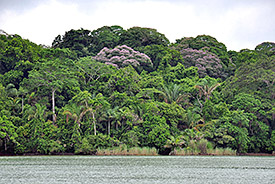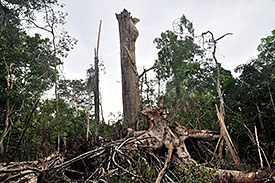Press information, 9 September 2014
The saplings go their own way
A new explanation for the dominance of generalists among tropical trees
Leipzig. In tropical rainforests, most young trees grow spatially independent from their parent trees. This means that it is not possible to predict where seedlings will take root, and less specialised species therefore have an advantage even in the species-rich rainforests of the tropics. This is the finding of a study, conducted by researchers at the Helmholtz Centre for Environmental Research (UFZ), the University of California and the Smithsonian Tropical Research Institute, the results of which were published recently in the prestigious journal Proceedings of the Royal Society B.

A diverse, lowland tropical forest in the Panama Canal. On Barro Colorado Island this rain forest hosts more than 300 tree and shrub species.
Photo: Stephan Getzin/UFZ

Remnants of BCI's famous Big Tree, which died in 2013 on the island. This kapok tree (Ceiba pentandra) had a crown averaging 60 m in diameter.
It was the largest crown known on the planet for a tree with a single stem.
Photo: Stephan Getzin/UFZ
For their study the scientists evaluated data from six forest censuses conducted over the past decades on Barro Colorado Island in the Panama Canal. A total of 300 different tree species grow in this 50 ha lowland rainforest. 65 species were selected on an area measuring 1000 x 500 metres. Each species was represented by at least 50 recruits and at least 50 adults, so as to rule out statistical errors. The researchers analysed the spatial distribution between the different generations and found no spatial association between the parent trees and their offspring in around three-quarters of the species. “This result was very surprising because seed dispersal in this tropical forest is usually very limited, so we would expect the offspring to grow close to the parent trees,” explains Dr Stephan Getzin of the UFZ. The researchers call the pattern they observed “spatial independence” and believe it stems from random spatial processes, including seed dispersal by animals. The stochastic spatial processes interfere with the classic ecological theory of predictable dependence, resulting in de facto independence.
The results of the study support the “neutral theory” developed by Stephen P. Hubbell of the University of California, who was also involved in this paper. Neutral theory attempts to explain the biodiversity of tropical rainforests with the simplified assumption that all tree species behave in the same way. Stochastic processes play an important role in this theory. In species-rich forests, every tree has random neighbours. According to Hubbell, species have become generalists because they do not know which neighbours they will be competing with. The new study shows that stochastic influences also play an important part in determining the location of young trees, i.e. the type of habitat in which they will grow, which again turns tree species into generalists.
The data from the lowland rainforest of Panama and the tree coordinates from a mountainous rainforest of Sri Lanka form a unique resource. In these two rainforests, the Smithsonian Tropical Research Institute and countless volunteers have for years been recording every tree with a diameter wider than a pencil on a plot measuring between 25 and 50 hectares. A forest census is carried out every five years, so it is likely that no other forest in the world is as well documented as these two. They represent unique opportunities for biodiversity researchers to explore the interactions between different plant species. UFZ researchers use rainforest models like FORMIND and FORMIX3 for this purpose. “Our model covers between 50,000 and 100,000 trees and every change has to be calculated for every tree. This results in two million sets of parameters for each simulation run, which takes a week or two even with high-performance computers,” explains Dr Thorsten Wiegand of the UFZ.
The recently published research findings are part of the Spatiodiversity project. A team of ten scientists led by UFZ modelling experts Dr Thorsten Wiegand and Prof. Andreas Huth have spent the last
five years using computer models to analyse ecosystems to explore the composition and dynamics of species-rich communities in tropical rainforests. The research received over two million euros in funding
from the European Research Council (ERC), since advances in this field are important for protecting biodiversity in the context of climate and land use changes, and for calculating carbon balances.
Tilo Arnhold
Publication
Getzin S, Wiegand T, Hubbell SP. (2014):
Stochastically driven adult–recruit associations of tree species on Barro Colorado Island. Proc. R. Soc. B, 20140922.
http://dx.doi.org/10.1098/rspb.2014.0922
The study was founded by the European Research Council (ERC advanced grant no. 233066), the National Science Foundation (NSF), the Center for Tropical Forest Science, the Smithsonian Tropical Research Institute, the John D. and Catherine T. MacArthur Foundation, the Mellon Foundation, the Celera Foundation und supported by numerous private individuals.
Further information
Helmholtz Centre for Environmental Research (UFZ)
Dr. Stephan Getzin, PD Dr. habil. Thorsten Wiegand
Telephone +49 341 235-1719, -1714
Dr. Stephan Getzin
PD Dr. habil. Thorsten Wiegand
or
Helmholtz Centre for Environmental Research
Susanne Hufe, Tilo Arnhold (UFZ press office)
Telephone +49 341 235-1635, -1630
Additional links
ERC advanced grant „Spatiodiversity - Towards a unified spatial theory of biodiversity“
www.helmholtz.de/forschung/eu_projekte/ideen/erc_advanced_grants/spatiodiversity/
Hubbel Lab at the University of California
www.stri.si.edu/english/scientific_staff/staff_scientist/scientist.php?id=16
Center for Tropical Forest Science at the Smithsonian Tropical Research Institute
www.ctfs.si.edu
Barro Colorado Island (BCI)
www.stri.si.edu/english/research/facilities/terrestrial/barro_colorado/
ERC provides millions for biodiversity research (Press release from October 29th, 2009)
www.ufz.de/index.php?en=19003
Spatial patterns in tropical forests can help to understand their high biodiversity (Press release, September 25th, 2007)
www.ufz.de/index.php?en=15138
In the Helmholtz Centre for Environmental Research (UFZ), scientists conduct research into the causes and consequences of far-reaching environmental changes. Their areas of study cover water resources, biodiversity, the consequences of climate change and possible adaptation strategies, environmental technologies and biotechnologies, bio-energy, the effects of chemicals in the environment and the way they influence health, modelling and social-scientific issues. Its guiding principle: Our research contributes to the sustainable use of natural resources and helps to provide long-term protection for these vital assets in the face of global change. The UFZ employs more than 1,100 staff at its sites in Leipzig, Halle and Magdeburg. It is funded by the federal government, Saxony and Saxony-Anhalt.
The Helmholtz Association contributes to solving major and urgent issues in society, science and industry through scientific excellence in six research areas: Energy, earth and environment, health, key technologies, structure of matter as well as aviation, aerospace and transportation. The Helmholtz Association is the largest scientific organisation in Germany, with 35,000 employees in 18 research centres and an annual budget of around €3.8 billion. Its work is carried out in the tradition of the great natural scientist Hermann von Helmholtz (1821-1894).
